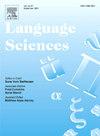在结构不同的语言中,我们使用的隐喻是否遵循相同的模式?
IF 1.1
2区 文学
Q2 EDUCATION & EDUCATIONAL RESEARCH
引用次数: 0
摘要
世界上不同语言的讲者在空间运动方面谈论一系列广泛的抽象概念(即隐喻运动事件;例如,想法在脑海中掠过,时间飞逝,情绪狂奔;Lakoff和Johnson, 1980)。在这项研究中,我们询问了隐喻动作事件的哪些方面在三种结构不同的语言(德语、波兰语和西班牙语)中表现出跨语言的相似性和差异性。我们对从三种语言(150种/种语言)的小说中提取的450个隐喻运动描述进行了随机抽样分析,结果显示出强大的跨语言相似性:三种语言的作品用相同的隐喻映射(抽象概念是一个移动的实体;抽象概念是一个位置)以相似的速度描述了相同类型的目标域(抽象实体、抽象状态、感知活动、虚构活动)的隐喻运动。强大的跨语言相似性伴随着源域规范的模式变化,主要遵循世界语言之间的二元类型分裂(Talmy, 2000):与西班牙作家相比,波兰和德国作家在方式上产生了更多的隐喻动作描述。因此,我们的研究结果为普遍的和特定语言的力量提供了强有力的证据,这些力量共同塑造了我们将抽象概念作为物理运动来构建和谈论的方式。本文章由计算机程序翻译,如有差异,请以英文原文为准。
Do metaphors we move by follow the same patterns across structurally different languages?
Speakers across different languages of the world talk about a wide array of abstract concepts in terms of spatial motion (i.e., metaphorical motion events; e.g., idea crosses the mind, time flies by, emotions run wild; Lakoff and Johnson, 1980). In this study, we asked what aspects of a metaphorical motion event show crosslinguistic similarities as well as differences across three structurally different languages (German, Polish, Spanish). Our analysis of 450 metaphorical motion descriptions, extracted from novels written in each of the three languages (150/language) using random sampling, showed robust cross-linguistic similarities: productions in all three languages described the metaphorical motion of the same types of target domains (abstract entity, abstract state, perceptual activity, fictive activity) with the same metaphorical mappings (abstract concept is a moving entity; abstract concept is a location) at similar rates. The robust crosslinguistic similarities were accompanied by patterned variability in the specification of the source domain, largely following a binary typological split between the world's languages (Talmy, 2000): Polish and German writers produced greater metaphorical motion descriptions with manner compared to Spanish writers. Our results thus provide strong evidence for both universal and language-specific forces that jointly shape the way we structure and talk about abstract concepts as physical motion.
求助全文
通过发布文献求助,成功后即可免费获取论文全文。
去求助
来源期刊

Language Sciences
Multiple-
CiteScore
2.90
自引率
0.00%
发文量
38
期刊介绍:
Language Sciences is a forum for debate, conducted so as to be of interest to the widest possible audience, on conceptual and theoretical issues in the various branches of general linguistics. The journal is also concerned with bringing to linguists attention current thinking about language within disciplines other than linguistics itself; relevant contributions from anthropologists, philosophers, psychologists and sociologists, among others, will be warmly received. In addition, the Editor is particularly keen to encourage the submission of essays on topics in the history and philosophy of language studies, and review articles discussing the import of significant recent works on language and linguistics.
 求助内容:
求助内容: 应助结果提醒方式:
应助结果提醒方式:


